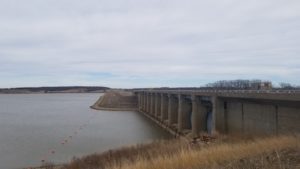Conservation needed to avoid more restrictive measures

Drought conditions in southeast Kansas are to thank for declining levels of water supply for Bartlesville and the surrounding area, Water Utilities Director Terry Lauritsen said this week.
“The City’s primary water supply resource is Hulah Lake, and while the lake itself is located just north and west of Bartlesville, its watershed is located in southeast Kansas,” Lauritsen said. “So while we do derive some benefit from local rainfall, that watershed is where we really need it to rain. And at this point, we need a good amount of it to make a difference in our overall supply.”
The City supplies water not only for Bartlesville residents but also the towns of Dewey, Ochelata, and Ramona, as well as several rural water districts. Water from Hulah Lake is pumped into the City-owned Hudson Lake. It is taken from Hudson Lake and treated at the City’s water treatment plant before being distributed to the City’s water customers.
Drought conditions throughout the region prompted the City to issue a call to citizens to conserve water due to the lack of rainfall, in accordance with Stage 2 of the 2002 Drought Contingency Plan. Stage 2 of the plan calls for voluntary conservation efforts and specifically focuses on limited outdoor watering and other outdoor water use.
“Because this isn’t really the season where a lot of outdoor water use is occurring, we’ve asked everyone to conserve where they can — to take shorter showers, turn off the water when it’s running unnecessarily, and replace defective parts on toilets, for instance,” Lauritsen said.
The call for conservation began in December 2022, but so far water supply levels have continued to fall, Lauritsen said.
“We’re down to 65 percent of overall water supply in comparison to 71 percent in December, which is where we were when we first asked citizens to conserve,” he said. “We really need to see these numbers go up — or at least create a holding pattern — to stave off moving to more restrictive measures.”
If water supply continues to decline, future conservation measures could include tightened restrictions on outdoor watering, including at golf courses and parks, as well as potential increases in water rates in an effort to curb use.
“Last week, our use was 4.4 million gallons of water per day, which is pretty typical for this time of year,” Lauritsen said. “We anticipate that number will be higher next week, as we had six water line breaks over the weekend.”
Lauritsen said while rain in the Hulah Lake watershed is the single-most productive solution that could occur, supply is also hindered somewhat by the Caney River Pump Station being offline due to disruption in the supply chain and the inability to obtain parts need to operate the motors correctly.
“We are working to find these parts through another vendor, which would, hopefully, allow us to get by without implementing more extreme measures in the interim period between now and typical spring rainfall,” he said.
Additionally, City staff are reviewing the 2002 Drought Contingency Plan and hope to propose updates for portions of the outdated plan during the City Council’s March meeting.
Look for updates on this story in upcoming editions of City Beat.
Photo provided by Dale Copeland.
Learn how you can help:
